|

SASSY BALD EAGLE CHICKS: NOT BALD AT ALL BUT
SURPRISINGLY FLUFFY
American Timeline: 1492-Today
October 12, 1492
 Christopher Columbus, Spanish
flag in suitcase, arrives in the Americas.
Christopher Columbus, Spanish
flag in suitcase, arrives in the Americas.
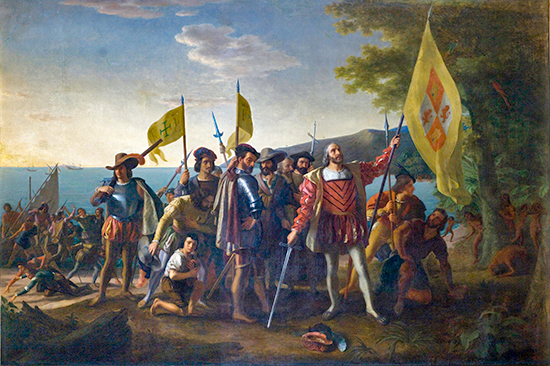
Landing of Columbus
Oil on canvas by John Vanderlyn,
Architect of the Capitol
Columbus and his crew make landfall on
the island of Guanahani, probably San Salvador Island, also called
Watlings Island, one of the Bahamas islands.
April 1513
Juan Ponce de León of Spain goes ashore on an island, or so he
thinks, and names it Florida.
1534
 Jacques Cartier explores the
St. Lawrence River for France.
Jacques Cartier explores the
St. Lawrence River for France.
1540
 The
American Indian Wars begin.
The
American Indian Wars begin.
1541
Spanish conquistador
Hernando de Soto explores the
Mississippi River.
1565
Saint Augustine (today's
northeastern Florida, about 40 miles or 65 km southeast of
Jacksonville), the oldest
permanent settlement in the US, is founded by the Spanish.
1607
Jamestown, Virginia, the first English
permanent settlement in North America, is founded. The Virginia Company
of London decides this site is the perfect location because no
Indians live here. Turns out, the property was vacant for a reason.
You couldn't get anything to grow on this swampy land.
1620
Pilgrims from the ship
 Mayflower set up a
settlement at Plymouth, Plymouth Colony, near Cape Cod.
Mayflower set up a
settlement at Plymouth, Plymouth Colony, near Cape Cod.
1649
The Act Concerning Religion
passed by the General Assembly, aka Maryland's legislature, is the first law of religious
toleration in the English colonies.
1682
French explorer
Sieur de La Salle investigates
the lower Mississippi valley and claims the entire region for
France. He calls it Louisiana.

French Louisiana
1682�1762
NPS.gov
1733
Georgia, the 13th and last of
the English colonies in America, is founded.
1754
The
 French and Indian War between
France and England begins in America.
French and Indian War between
France and England begins in America.
1763
The
 Treaty of Paris ends the French
and Indian War. The French leave, the British take over. See also the
Treaty of Paris ends the French
and Indian War. The French leave, the British take over. See also the
 Seven Years' War.
Seven Years' War.
1765
The
Quartering Act and the Stamp Act
anger Americans. Nine colonies are represented at the Stamp Act
Congress.
1770
British troops fire on a crowd,
killing five people in the so-called
 Boston Massacre.
Boston Massacre.
1773
The
 Boston Tea Party, the first
action in a chain leading to war with Britain, takes place.
Boston Tea Party, the first
action in a chain leading to war with Britain, takes place.
1774
The First Continental Congress
meets at Philadelphia and protests the five
Intolerable Acts, also called the Coercive Acts.
Meanwhile, Britain closes down Boston harbor and deploys troops in
Massachusetts.
1775
The
 battles of Lexington and Concord
and
battles of Lexington and Concord
and
 Bunker Hill occur. George
Washington on the roll.
Bunker Hill occur. George
Washington on the roll.
The Second
Continental Congress meets.
1776
The
 Declaration of Independence is
adopted by Congress. Thomas Jefferson is pleased and the colonies
declare independence.
Declaration of Independence is
adopted by Congress. Thomas Jefferson is pleased and the colonies
declare independence.
1778 - 1779
General
George Rogers Clark leads a victorious expedition into
the Northwest Territory. Here is his route on a map. Look for
Inset B.
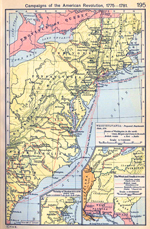
American
Revolution 1775-1781
1781
 George Washington accepts the
surrender of Charles Cornwallis
at Yorktown VA after the defeat of the British at the
Battle of Yorktown. The Articles of Confederation become the government
of the US.
George Washington accepts the
surrender of Charles Cornwallis
at Yorktown VA after the defeat of the British at the
Battle of Yorktown. The Articles of Confederation become the government
of the US.
June 20, 1782
The bald eagle becomes officially
the national emblem of the United States, so declare the
founding fathers at the Second Continental Congress.
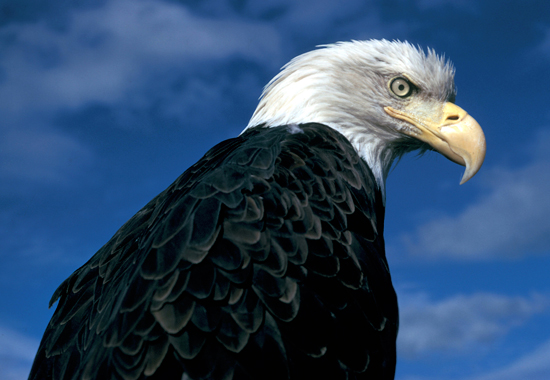
The (Very Lousy) Bald Eagle
Glacier National Park Wildlife,
NPS
Why a Bald Eagle? How about a Bold
Turkey?
Along those
lines, here are
 Benjamin Franklin's
remarks to his daughter,
Sarah Bache,
in 1784, in which he criticizes a veterans'
organization (the American Order of the
Cincinnati) for choosing the bald eagle as
their emblem.
Benjamin Franklin's
remarks to his daughter,
Sarah Bache,
in 1784, in which he criticizes a veterans'
organization (the American Order of the
Cincinnati) for choosing the bald eagle as
their emblem.
"Others object to the bald eagle [i.e., on
the Cincinnati's emblem] as looking too much
like a dindon, or turkey. For my own part, I
wish the bald eagle had not been chosen as
the representative of our country; he is a
bird of bad moral character; he does not get
his living honestly ... like those among men
who live by sharping and robbing ... he is
generally poor, and often very lousy.
Besides, he is a rank coward; the little
king-bird, not bigger than a sparrow,
attacks him boldly and drives him out of the
district ... I am, on this account, not
displeased that the figure [i.e., the
Cincinnati's drawing] is not known as a bald
eagle, but looks more like a turkey. For in
truth, the turkey is in comparison a much
more respectable bird, and withal a true
original native of America. Eagles have been
found in all countries, but the turkey was
peculiar to ours ... He is, besides, (though
a little vain and silly, it is true, but not
the worse emblem for that), a bird of
courage, and would not hesitate to attack a
grenadier of the British guards, who should
presume to invade his farmyard with a red
coat on".
Massachusetts
Division of Fisheries and Wildlife
1783
The 1783
 Peace of Paris formally ends the Revolutionary War. Britain accepts the loss of the colonies.
Peace of Paris formally ends the Revolutionary War. Britain accepts the loss of the colonies.
1786 - 1787
Shays's Rebellion in
Massachusetts shows weaknesses of the Confederation government.
1788
The
 US Constitution is ratified
by the necessary nine states to ensure adoption.
US Constitution is ratified
by the necessary nine states to ensure adoption.
1789
The new US government goes into
effect.
 George Washington is inaugurated president.
Go here for
George Washington is inaugurated president.
Go here for
 George Washington's First Inaugural Address.
George Washington's First Inaugural Address.
The first Congress
meets in New York City.
1791
The
 Bill of Rights is added to
the Constitution and guarantees individual freedom.
Bill of Rights is added to
the Constitution and guarantees individual freedom.
Vermont is the first new state admitted to the
Union.
1793
Eli Whitney invents the cotton
gin, which leads to large-scale cotton growing in the South.
1800
The national capital is moved
from Philadelphia to Washington DC.
1803
Louisiana territories are purchased from
France. Here is more on the
 Louisiana Purchase.
Louisiana Purchase.
1804 - 1806
 Meriwether Lewis and
Meriwether Lewis and
 William
Clark blaze an overland trail to the Pacific and return.
William
Clark blaze an overland trail to the Pacific and return.
1807
Robert Fulton's steamboat makes
a successful journey from New York City to Albany NY.
1808
Atlantic slave trade abolished.
1812 - 1815
The U.S. fights Great Britain
for the second and last time. This is the
 War of 1812.
War of 1812.
1820
The
 Missouri Compromise settles
the problem of slavery in new states for the next 30 years. This map
illustrates free and slave territory, and then
some.
Missouri Compromise settles
the problem of slavery in new states for the next 30 years. This map
illustrates free and slave territory, and then
some.
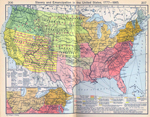
1777-1865 United
States Slavery and Emancipation
1823
The
 Monroe Doctrine warns
European nations that the US will protect the Americas.
Monroe Doctrine warns
European nations that the US will protect the Americas.
1825
The Erie Canal, from the Hudson
River to the Great Lakes, becomes a great water highway to the
Middle West.
1829
The inauguration of
 President
Andrew Jackson introduces the era of Jacksonian Democracy. Here you can read
President
Andrew Jackson introduces the era of Jacksonian Democracy. Here you can read
 Jackson's First Inaugural Address.
Jackson's First Inaugural Address.
1836
Texas wins its independence
from Mexico by means of the
 Texas Revolution.
Texas Revolution.
1843
The first migration begins on
the Oregon Trail. And here is
the Oregon Trail on a map:
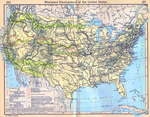
1790-1900 United States
1845
Texas is annexed and admitted
as a state. Here is a
 map of Texas in 1845.
map of Texas in 1845.
1846
The Oregon boundary dispute is
settled with Britain. The
 Mexican War begins.
Mexican War begins.
1847
Brigham Young leads a party of
Mormons into the Salt Lake valley, Utah.
1848
The
 Mexican War ends. The US
gains possession of the California and New Mexico regions.
Mexican War ends. The US
gains possession of the California and New Mexico regions.
1849
The
 California gold rush begins.
California gold rush begins.
1850
The Compromise of 1850 admits
California as a free state, postponing war between the North and
South. Here is more on
 Daniel Webster.
Daniel Webster.
1853
The
 Gadsden Purchase adds
117,935 sq km (45,535 sq mi) to what is now the southwestern US.
Gadsden Purchase adds
117,935 sq km (45,535 sq mi) to what is now the southwestern US.
1854
The Republican Party is
organized in opposition to slavery.
1857
The Dred Scott decision of the
Supreme Court declares that the Missouri Compromise is illegal.
1860
 Abraham Lincoln is elected
president. South Carolina secedes from the Union.
Abraham Lincoln is elected
president. South Carolina secedes from the Union.
1861
The
 Confederate States of
America is formed by eleven pro-slavery southern
states under the leadership of
Confederate States of
America is formed by eleven pro-slavery southern
states under the leadership of
 Jefferson Davis. The
Jefferson Davis. The
 Civil War begins.
Civil War begins.
Telegraph links New York
City with San Francisco.
1862
 General Ulysses S. Grant launches
a Union attack in the West. The Confederate invasion of Maryland is
halted at Antietam. The Homestead Act grants 160 acres to each
settler.
General Ulysses S. Grant launches
a Union attack in the West. The Confederate invasion of Maryland is
halted at Antietam. The Homestead Act grants 160 acres to each
settler.
1863
Federal forces win decisive
battles at Gettysburg PA, Vicksburg MS, and Chattanooga TN.
The
Emancipation Proclamation is delivered,
issued by Lincoln, declaring slaves in Confederate states to be free.
1864
General William Tecumseh Sherman
captures Atlanta and marches across Georgia.
1865
 General Robert E. Lee surrenders
to
General Robert E. Lee surrenders
to
 General Ulysses S. Grant at
Appomattox (VA) Court House, ending the
General Ulysses S. Grant at
Appomattox (VA) Court House, ending the
 Civil War. The Confederates are
defeated.
Civil War. The Confederates are
defeated.
Slavery is abolished under the
Thirteenth Amendment.
 Abraham Lincoln is assassinated.
Abraham Lincoln is assassinated.
1867
Reconstruction acts impose
military rule on the South.
 Alaska is purchased from Russia.
Alaska is purchased from Russia.
1869
The first transcontinental
railroad is completed as two lines meet at Promontory UT.
1876
The telephone is invented.
The
Centennial Exposition in Philadelphia celebrates the 100th birthday
of the US.
Sioux Indians are defeated by US
troops at
 Little Bighorn (Little Big Horn)
Little Bighorn (Little Big Horn)
1877
The withdrawal of the last
federal troops from the South ends the Reconstruction period.
1879
The first practical electric
light is invented by
 Thomas A. Edison.
Thomas A. Edison.
1890
The Sherman Anti-Trust Act is
passed in an effort to curb the growth of monopolies.
US troops defeat Sioux Indians at
 Wounded Knee.
Wounded Knee.
1896
Henry Ford�s first car is
driven on the streets of Detroit.
1898
The United States annex Hawaii.
The U.S. wins the
 Spanish-American War and gains the Philippines, Puerto Rico,
and
Guam. Cuba becomes independent.
Spanish-American War and gains the Philippines, Puerto Rico,
and
Guam. Cuba becomes independent.
1903
The air age begins with the
successful airplane flight by the Wright brothers.
1913
Federal income tax is
authorized by the 16th Amendment.
1914
The
 Panama Canal is opened
under the control of the US.
Panama Canal is opened
under the control of the US.
 World War I breaks out in Europe.
World War I breaks out in Europe.
 President
Woodrow Wilson appeals for neutrality in the US.
President
Woodrow Wilson appeals for neutrality in the US.
1915
A German submarine sinks the
British ship Lusitania with the loss of 124 American lives.
A
telephone line is established coast-to-coast.
1916
The
Great Migration begins. By the year 1970, 6 to 7 million
African Americans will have moved from the South to the North.
1917
The US declares war against
Germany.
 Check this event in the Timeline of World War
I.
Check this event in the Timeline of World War
I.
1918
 President
Woodrow Wilson proposes Fourteen
Points as the basis for peace. Here you can read his
President
Woodrow Wilson proposes Fourteen
Points as the basis for peace. Here you can read his
 Fourteen Points speech.
Fourteen Points speech.
Americans fight at Ch�teau-Thierry,
Belleau Wood, Saint-Mihiel, and Argonne Forest in France. An
armistice ends the war.
1918 - 1919
 President
Woodrow Wilson attends the Paris
Peace Conference of victorious nations.
President
Woodrow Wilson attends the Paris
Peace Conference of victorious nations.
1919
The US Senate rejects the
League of Nations.
Prohibition is established by the
18th Amendment.
1920
The right to vote is given to
women by the 19th Amendment.
1924
Congress grants the right to
citizenship to Native Americans.
1927
Charles A. Lindbergh makes the
first nonstop solo flight across the Atlantic.
1928
The Kellogg-Briand Pact outlaws
war.
1929
The stock market reaches a new
high and then crashes. The panic marks the beginning of the
 Great
Depression. Thirteen million workers become unemployed.
Great
Depression. Thirteen million workers become unemployed.
 Herbert Hoover has to work
overtime.
Herbert Hoover has to work
overtime.
1932
 Franklin Delano Roosevelt is
elected president.
Franklin Delano Roosevelt is
elected president.
1933
FDR launches the
 New Deal, a recovery program
that includes major public works. The
gold standard is suspended.
New Deal, a recovery program
that includes major public works. The
gold standard is suspended.
The National Recovery Act is passed.
Bank deposits are insured. The Tennessee Valley Authority is
organized.
The 21st Amendment repeals prohibition
and the sale of alcohol resumes.
1938
The Fair Labor Standards Act
provides a federal yardstick for wages and hours of workers.
1939
Germany invades Poland,
beginning
 World War II. The US declares neutrality.
World War II. The US declares neutrality.
1940
The US begins a huge rearmament
program; the first peacetime draft takes effect.
 Franklin Delano Roosevelt defies
tradition and accepts the presidential nomination for a third term.
Franklin Delano Roosevelt defies
tradition and accepts the presidential nomination for a third term.
1941
The Japanese attack on
 Pearl
Harbor, Hawaii, brings the US into
Pearl
Harbor, Hawaii, brings the US into
 World War II. Germany declares
war on the US.
World War II. Germany declares
war on the US.
 Check this event in the Timeline of WWII.
Check this event in the Timeline of WWII.
1942
Americans launch a
counteroffensive in the Pacific. The Allies invade North Africa.
1943
The invasion of Italy is the
Allies� first landing on the European continent.
June 6,
1944
The Allies launch the greatest
sea-to-land assault in history in the invasion of France.
 Check this event in the Timeline of WWII.
Check this event in the Timeline of WWII.
The GI
Bill of Rights is passed.
May 8,
1945
Germany surrenders.
August 6,
1945
The
US drops atomic bombs on Japan at Hiroshima
August 9,
1945
The US drops atomic bombs on
Japan at Nagasaki.
September 2,
1945
Japan surrenders. The
 Cold War begins between
the US and the Soviet Union.
Cold War begins between
the US and the Soviet Union.
1946
The Philippines is granted
independence by the US.
1947
The
 Truman Doctrine, offering
aid to counter
Truman Doctrine, offering
aid to counter
 communism in Greece and Turkey, is declared.
communism in Greece and Turkey, is declared.
1947
The
 Marshall Plan, a program
to aid post-war European economies, transfers 13 billion dollars
into Europe.
Marshall Plan, a program
to aid post-war European economies, transfers 13 billion dollars
into Europe.
1949
The US and its allies force the Soviet Union to
lift the Berlin blockade.
The North Atlantic Treaty Organization
( NATO) is founded.
NATO) is founded.

Map of NATO and its members 1949-2024
1950
The US and several other
members of the UN send military forces to the aid of the Republic of
Korea. Bitter war develops against North Korean and Chinese troops.
More on the
 Korean War.
Korean War.
1951
A two-term limit is put on the
presidency by ratification of the 22nd Amendment.
1952
The US and its allies end the
occupation of West Germany. The election of
 Dwight D. Eisenhower
ends 20 years of Democratic governance. Dwight D. Eisenhower
ends 20 years of Democratic governance.
1953
The
 Korean War ends.
Korean War ends.
1954
Racial segregation in public
schools is declared illegal by the Supreme Court.
The Senate finally gets a handle on
the
 Red Scare, aka McCarthyism, the
crusade against alleged communists carried out by
Red Scare, aka McCarthyism, the
crusade against alleged communists carried out by
 Senator Joseph McCarthy.
Senator Joseph McCarthy.
Start of campaign of civil
disobedience to secure civil rights for Americans of African
descent.
1957
The Eisenhower Doctrine to
strengthen the US position in the Middle East is adopted.
1959
Alaska becomes the 49th state,
Hawaii the 50th.
1960
A US spy plane is downed over
the Soviet Union.
 President John F. Kennedy is
elected president.
President John F. Kennedy is
elected president.
1961
The CIA is involved in an
unsuccessful invasion of Cuba at the Bay of Pigs.
More on the
 Bay of Pigs Invasion.
Bay of Pigs Invasion.
American troops are
sent to defend West Berlin.
1962
The
 Cuban missile crisis
erupts. The Soviets remove missiles from Cuba at the urging of the
US.
Cuban missile crisis
erupts. The Soviets remove missiles from Cuba at the urging of the
US.
1963
The March on Washington for
Jobs and Freedom takes place.
 President John F. Kennedy is assassinated
in Dallas TX.
President John F. Kennedy is assassinated
in Dallas TX.
 Lyndon Baines Johnson becomes
president.
Lyndon Baines Johnson becomes
president.
1964
The landmark
 Civil Rights Act
is passed, now law. It aims to halt discrimination on grounds of
race, color, religion, or nationality.
Civil Rights Act
is passed, now law. It aims to halt discrimination on grounds of
race, color, religion, or nationality.
The US steps up its military
interventions in Vietnam.
1965
US combat forces fight in
Vietnam. More on the
 Vietnam War.
Vietnam War.
1967
The 25th Amendment to the
Constitution provides for presidential succession.
1968
The assassinations of
 Martin
Luther King, Jr., and
Martin
Luther King, Jr., and
 Robert F. Kennedy provoke riots.
Robert F. Kennedy provoke riots.
1969
 Richard Nixon is elected
president while people are fed up with the Vietnam War.
Richard Nixon is elected
president while people are fed up with the Vietnam War.
Neil
Armstrong is the first person to walk on the Moon.
1970
Four students at Kent State
University in Ohio are killed by National Guard soldiers during
anti-Vietnam War protests.
1971
The 26th Amendment to the
Constitution gives 18-year-olds the right to vote in all elections.
1972
 President Richard M. Nixon is
re-elected and visits
China and the Soviet Union.
President Richard M. Nixon is
re-elected and visits
China and the Soviet Union.
1973
Vietnam ceasefire agreement
signed. The US withdraws its troops
from Vietnam. The campaign had claimed some 58,000 American lives. More on the
 Vietnam War.
Vietnam War.
1974
The
 Watergate Scandal and the
threat of impeachment force
Watergate Scandal and the
threat of impeachment force
 President Richard M. Nixon
to resign.
President Richard M. Nixon
to resign.
 Gerald Ford is sworn-in as
Nixon's successor.
Gerald Ford is sworn-in as
Nixon's successor.
1976
 Jimmy Carter elected president.
Jimmy Carter elected president.
1978
 President Jimmy Carter hosts the
Camp David talks between Israel�s Menachem Begin and Egypt�s
Anwar
el-Sadat.
President Jimmy Carter hosts the
Camp David talks between Israel�s Menachem Begin and Egypt�s
Anwar
el-Sadat.
1979
The second Strategic Arms
Limitation Talks ( SALT II) treaty is signed by the US and the Soviet
Union.
SALT II) treaty is signed by the US and the Soviet
Union.
Militants seize 66 American hostages
in a takeover of the US embassy in Teheran, Iran. A 444-day hostage
crisis begins.
1980 / 1981
 President Ronald Reagan adopts
a tough anti-communist foreign policy and tax-cutting policies that
lead to a large federal budget deficit.
President Ronald Reagan adopts
a tough anti-communist foreign policy and tax-cutting policies that
lead to a large federal budget deficit.
Reagan is wounded
in an assassination attempt.
Sandra Day O�Connor is appointed the
first woman Supreme Court justice.
1983
 President Ronald Reagan
announces the Star Wars
missile-defense program. The US invades Grenada.
President Ronald Reagan
announces the Star Wars
missile-defense program. The US invades Grenada.
1984
 President Ronald Reagan
is re-elected.
President Ronald Reagan
is re-elected.
1985
A summit between
 President Ronald Reagan
and
Soviet leader
President Ronald Reagan
and
Soviet leader
 Mikhail Gorbachev is held in Geneva, Switzerland.
Mikhail Gorbachev is held in Geneva, Switzerland.
1986
The space shuttle Challenger
explodes shortly after liftoff from Cape Canaveral. All seven crew
members are killed.
The US bombs targets in Libya.
The
Iran-Contra Affair is revealed, "Irangate" a scandal which exposed
that proceeds from secret US arms sales to Iran were used illegally
to fund Contra rebels in Nicaragua.
1987
The stock market collapses.
1988
Reagan's vice-president,
 George Bush, elected president.
George Bush, elected president.
1989
The Exxon Valdez supertanker
spills 10 million gallons of crude oil off the Alaskan coast.
The US
invades Panama, oust its government and arrest its leader, one-time
Central Intelligence Agency informant General Manuel Noriega, on
drug-trafficking charges.
The
 Berlin Wall ceases to divide the two Germanys,
signaling the end of the
Berlin Wall ceases to divide the two Germanys,
signaling the end of the
 Cold War. Cold War.
1990
US troops are sent to Saudi
Arabia in response to Iraq�s invasion of Kuwait.
More about the
 Gulf War.
Gulf War.
1991
An air and ground war leads to
the Iraqi surrender and withdrawal from Kuwait. The Soviet Union
comes apart.
1992
Riots erupt in Los Angeles
after white policemen accused of beating African American
Rodney
King are acquitted.
The North American Free Trade Agreement
(NAFTA) is signed by the US, Canada, and Mexico, intended to create
free-trade bloc among these three countries.
 Bill Clinton elected president.
Bill Clinton elected president.
1993
Janet Reno becomes the first
woman attorney general.
The World Trade Center in New York City is
bombed.
1994
Congress defeats Clinton's
flagship legislation intended to reform health care system.
Investigations into Whitewater
scandal, over the Clintons' financial dealings in Arkansas, where he
had been governor before becoming president.
Sexual harassment charges are filed
against Clinton by a former Arkansas employee. Mid-term elections
result in Republican majorities in both houses of Congress.
1995
Timothy McVeigh detonates a
bomb in a terrorist attack on the Alfred P. Murrah Federal Building
in Oklahoma City, killing 168 people.
Read the
 Oklahoma City Bombing Memorial Address.
Oklahoma City Bombing Memorial Address.
1996
 Bill Clinton re-elected
president.
Bill Clinton re-elected
president.
1998
 President Bill Clinton is impeached
for perjury and obstruction of justice. He will be acquitted by the
Senate in 1999. Not due to a lack of real problems, but by reason of
the incredible depth of the sticks in many rears, the
Clinton-Lewinsky scandal is all that is talked about for a long
time.
President Bill Clinton is impeached
for perjury and obstruction of justice. He will be acquitted by the
Senate in 1999. Not due to a lack of real problems, but by reason of
the incredible depth of the sticks in many rears, the
Clinton-Lewinsky scandal is all that is talked about for a long
time.
1999
US plays leading role in NATO
bombardment of Yugoslavia in response to Serb violence against
ethnic Albanians in the province of Kosovo.
2000
The results of the presidential
election are challenged by Vice President Al Gore. The US Supreme Court
overrules the Florida Supreme Court�s order for a statewide manual
recount of ballots.
 George W. Bush wins the presidency.
George W. Bush wins the presidency.
2001, September 11
Two hijacked
airplanes demolish the World Trade Center in New York City, another
crashes into the Pentagon outside Washington DC, and a fourth
crashes in the southern Pennsylvania countryside.
3,025 people are killed in the
attacks.
 George W. Bush calls
for a global War on Terror and sends US troops into Afghanistan,
eventually displacing the Taliban regime.
George W. Bush calls
for a global War on Terror and sends US troops into Afghanistan,
eventually displacing the Taliban regime.
2003
February: - Space shuttle
Columbia's 28th mission ends in tragedy when the craft breaks-up
while re-entering the atmosphere. The seven astronauts on board are
killed.
March: - The US launches the
 Iraq War to depose
the Saddam Hussein regime in Iraq and takes control of the country
after just weeks of fighting.
Iraq War to depose
the Saddam Hussein regime in Iraq and takes control of the country
after just weeks of fighting.
August, 14: - Biggest power blackout
in North American history hits cities in the north and east,
including New York, as well as Canadian cities.
2004
July: - The independent 9/11 Commission finds no credible evidence
of a connection between Iraq and al-Qaeda's attacks of September 11, 2001.
 George W. Bush is reelected president.
George W. Bush is reelected president.
2005, August
Hundreds of
people are killed when Hurricane Katrina, the most destructive storm
to hit the US in decades, sweeps through gulf coast states. Much of
the city of New Orleans is submerged by flood waters.
2008
A crisis in the subprime
mortgage industry, leading to foreclosures and falling home values,
together with record-high prices of petroleum, pushes the US economy
to the brink of recession. On September 15, the Lehman Brothers
investment banking house collapses into bankruptcy. Public
confidence in both the economy and government oversight plummets.
US troop deaths in Iraq top 4,100 by
July, while deaths in Afghanistan reach 475.
2009
 Barack Obama is sworn in as the first African American
president of the United States. Here you can read
Barack Obama is sworn in as the first African American
president of the United States. Here you can read
 Obama's Inaugural Address.
Obama's Inaugural Address.
American troops
meet the 30 June deadline to withdraw from Iraqi cities under an
agreement that calls for all American forces to leave Iraq by the
end of 2011.
2010
Deepwater Horizon oil rig
disaster in the Gulf of Mexico causes the United States' biggest oil
spill to date.
2011
January: US congresswoman
Gabrielle Giffords is shot in
the head while meeting voters in Tucson, Arizona. Giffords survives
but six people are killed in the rampage and 13 wounded.
May: US forces kill Al-Qaeda leader Osama
Bin Laden in an operation in the Pakistani city of
Abbottabad. Read President Obama's Address
 On the Death of Osama Bin Laden
On the Death of Osama Bin Laden
December: After 8 years, 9 months, and
12 days, the
 Iraq War is over.
Iraq War is over.
2013
On January 21, President Obama
delivers his
 Second Inaugural Address.
Second Inaugural Address.
More History
|